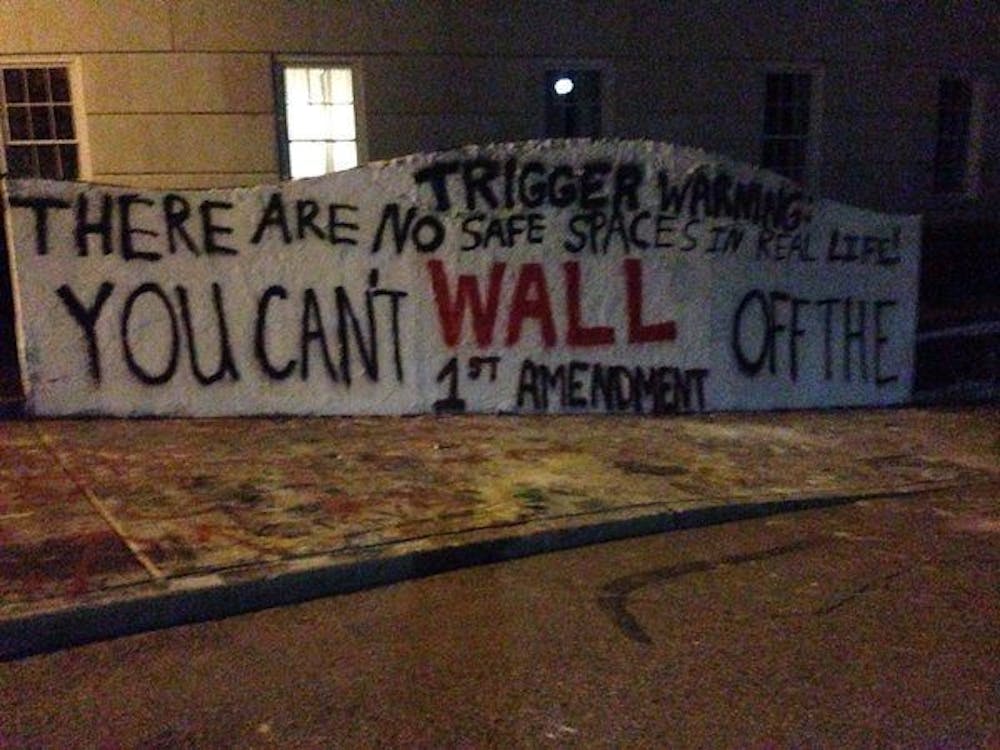The University of Chicago made national headlines about two weeks ago when its dean of students sent a letter to incoming freshman saying the university does not support “safe spaces” and “trigger warnings.”
The school in Chicago is not the only college campus discussing those topics. Ohio University students and faculty also have varying opinions on safe spaces and trigger warnings.
Trigger warnings are used to prepare people for discussions that may be "triggering," such as talking about sexual assault and violence. "Safe space" is a term some
Last academic year, the OU College Republicans made a statement about trigger warnings and safe spaces on the graffiti wall near Bentley Hall. The group painted the wall to say: "Trigger warning: There are no safe spaces in real life! You can’t wall off the 1st amendment.”
David Parkhill, president of the OU College Republicans, said the group painted the wall in response to the cancellation of Greek Week events. That was a result of the wall being painted in support of presidential candidate Donald Trump with the statement, “build the wall.”
“We believe that people were offended way too easily, and there was no place for the coddling of those minds on campus,” Parkhill said. “We just thought it was ridiculous and that it was an infringement of people’s constitutional right, especially for someone that was the frontrunner at the time, not yet the nominee, but the frontrunner of one of the two major parties in the United States.”
Trigger warnings are
“I don’t think there should be students that sit in the class and demand trigger warnings,” Parkhill said. “If that happens, what’s to say I’m triggered by the color blue, (and) you aren’t allowed to have any colors that remind me of the color blue on campus, and I think it just trickles down from there."
The Women’s Center Director M. Geneva Murray said trigger warnings and safe spaces are often “misinterpreted.”
“I think some of the things that have come up with them is it is impossible for us to give a trigger warning for everything,” Murray said. “That being said, I think it is good practice for us to provide trigger warnings when we’re doing material, and I think it’s important for us to be thinking about if we are assigning something that has graphic information, is that level of graphic information required to get the point across?”
Trigger warnings are sometimes taken as “we don’t have to engage with the issue,” she said, adding she thinks that was what the University of Chicago was addressing.
“From what I’ve seen, it tends to be liberal-minded people that are just so offended by certain things that people say,” Parkhill said. “They just can’t believe what’s going on, and they have to retreat to a safe space. I think that takes away from conversation and debate.”
The OU LGBT Center offers SafeZone training for people throughout the university. The purpose behind SafeZones is to create an opportunity and
“I don’t think it’s about ... making an easy space,”
Parkhill argues that safe spaces are trying to “shelter” college students from the “real world."
“Our kids can’t grow up in a soft world 'cause the real world is not soft,” he said. “I don’t think that’s gonna make a good generation.”
Trigger warnings and safe spaces,
“If a person just doesn’t want to talk about rape or doesn’t want to talk about LGBT equality or just doesn’t want to talk war ... we’re not giving them an excuse to leave,” they said. “That’s not the goal.”
Murray added trigger warnings and safe spaces are not to protect people from different ideas, but rather make people aware that everyone comes from different life experiences.
“I’m proud of U of C and would be thrilled to see Ohio University do something similar,” Parkhill added. “I highly doubt that will happen, but that would make (me), and probably the rest of the conservative base on campus, probably really happy.”






